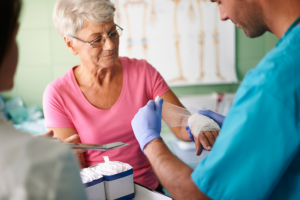Unfortunately, the human body is fragile. Unlike animals, humans don’t have sturdy shells and tough leathers. All they have is soft skin, which can only do so much in protecting the body against sharp and abrasive objects.
And while humans don’t regrow limbs, they can partially recover when wounded. Meanwhile, there are different phases of the recovery process, and it starts the moment a person receives a wound. If you’re interested in learning what happens during recovery, continue reading.
- Once Wounded, The Body Starts Hemostasis
Hemostasis is the combination of two Latin words: hemo, which means blood, and statis, which means standing still. Based on the English translation of the two words, you can safely assume that the primary purpose of hemostasis is to make the blood stand still or stop it from moving.
It’s a process in the human body that triggers multiple mechanisms to react to bleeding and attempt to repair the damage. If you’re currently under exosome therapy, this process can start faster. Its main goal is to prevent blood loss and avoid infections from arising.
- Blood Clotting Then Happens
When a person starts bleeding, hemostasis stops it through blood clotting. If you’ve been wounded before, you might have noticed that your blood starts to dry and solidify after a few minutes—that’s blood clotting in action. This blood clot acts as a plug to prevent blood from escaping and dripping nonstop.
Aside from blood clotting, hemostasis constricts blood vessels to limit the amount of blood circulating and slows down the bleeding from the open wound.
- These Clots Become Scabs
Blood platelets trigger clotting. Once they reach the wound site, they’ll immediately collect nutrients, primarily vitamin K, calcium, and fibrinogen (a type of protein), to form a fibrin clot. Fibrin is then built into a mesh-like structure that ends up as a scab. This defense not only blocks bleeding but also protects the wound site from further damage.
- When Homeostasis Is Finished, Inflammation Begins
The typical signs of inflammation are when a part of your body swells, generates pain, reddens, and heats up. When a wound stops bleeding, those signs of inflammation may appear in the area where the wound is.
Meanwhile, once hemostasis has achieved its goal of slowing down the bleeding, the body then proceeds with inflammation. You may have experienced it before and might be thoroughly familiar with it.
The signs of inflammation are caused by multiple elements like antibodies, enzymes, nutrients, and white blood cells that would respond to the damaged area of your body. These elements have a variety of functions in the body. However, when a wound is present, their primary goal is to accelerate the healing process and prevent complications from arising.
- The Body Then Initiates The Proliferation Process
As mentioned in the previous section, the body will send nutrients to the wounded area. Your body will then use these nutrients to create new granulation tissues to replace the damaged skin layer.
- Granulation Tissues Will Replace The Damaged Tissues
Aside from these tissues, the body will also form new blood vessel networks. This is to ensure that surrounding cells and tissues will get nutrient- and oxygen-enriched blood. After all, if those tissues and cells don’t receive those, they’ll die off and may start necrosis.
If you’ve been wounded before and removed your wound’s scab after a few days it was formed, you’ll be able to see the new tissues generated by proliferation. If the healing process is doing fine, the granulation tissue would appear reddish and pinkish. If there’s an infection, it’ll have a darker color.
- Once The Wound Is Healed Up, Maturation Will Be The Next Step
Once the wound is completely closed and scar tissue has formed, the maturation process will start. Its primary purpose is to strengthen the wound site and prevent your wound from opening up. Depending on the severity of the damage, this process may take years.
It’s the last process the wound site will go through before it becomes completely healed. In addition to strengthening the wound site, it’ll gradually reduce the number of blood vessels formed.
Conclusion
Those things happen during the healing process when a person is wounded. To recap, you can break up the healing process into four phases: hemostasis, inflammation, proliferation, and maturation. Depending on the severity of the wound, the amount of time it takes before the body shifts to the following process may vary.
Also, if complications arise, the body may restart some of the processes again. Therefore, to ensure a faster wound recovery, the patient should follow their doctor’s orders and prevent doing anything unnecessary to the wound.


